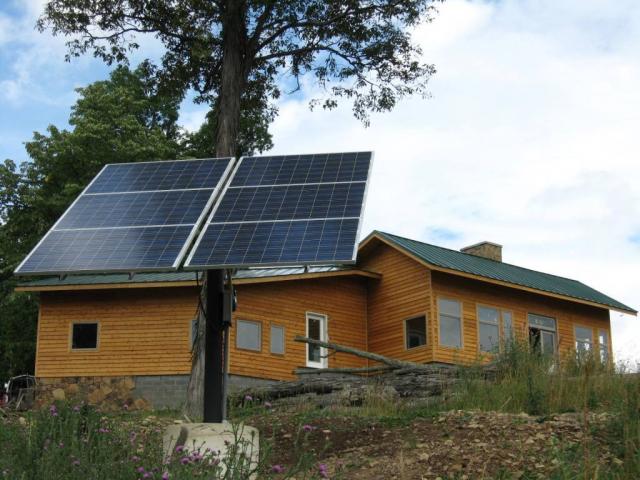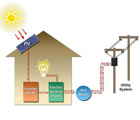

Determining the peak and average daily electrical load
Click here to download a PDF file with a sample load analysis.
The Excel spread sheet used in this example is available upon request. There are a number of useful observations that can be made about this particular home.
First some background. The house is near Kingston, and is a newly constructed house. It has one adult and one child as the only fully time occupants. This is a year round home. It uses propane is the primary heating fuel, and uses radiant hot water heating and hot water from an instantaneous condensing propane hot water heater.
If you examine the per day column to look for the highest amounts, these are the items that drive the cost of the system. Here are my comments on each of these items.
- Deep well pump. This one shows a high flow rate, and thus a relative short running time. If the well is very deep or is very far away the flow rate into the pressure tank will be lower, and the pump will run for a proportionally longer period each day, increasing the load. This calculation used an Ontario average urban water use of 274 L per person. In the winter you will not be watering the garden.
- Heating.The energy efficiency of the house determines how long per day the heating system must run, and thus the run time of fans, pumps, that comprise the heating system. A less efficient house will have a longer run time, and consume more electricity even though the heating fuel is not electricity.
- Refrigerator. Even though a modest sized fridge was selected by the owner, and it was selected on the basis of its energy star rating of 337 kWh/year, this translates into about 1/4 of the total load. Put another way, 1/4 of the solar panels are dedicated to the refrigerator. A propane fridge would significantly reduce the daily electrical load. In 2020 the best model 18 cuft2 GE fridge will use an energy star rated 359 kWh / year, for a full sized fridge.
- Dryer. An electric dryer is out of the question. This model uses an electric motor to rotate the drum, with an efficient motor, and the heat source is propane. Many natural gas dryers have a factory kit to convert them to propane, and there is a lot of choice for suitable dryers.
- The generator's cold start kit does not seem to draw very much power, but having it on 24 hours a day in cold weather still adds up to nearly a kW, or nearly 1/4 of the total load. This is a major concern. I suggest using an extra controller circuit to only turn this on when the battery is approaching the voltage at which the generator needs to start. This is similar to plugging in a car's block heater into a timer set to turn on only 4 hours before you need the car to start, instead of having plugged in all night. In warmer temperatures the heater does not turn on at all.
- The satellite receiver uses 7.4W when turned on, and 7.0W when on standby. Thus with 3 hours a day of TV, the satellite receiver has a daily load more than the TV. The satellite receiver could be unplugged when not in use, but then it would need a few minutes to reload your subscription data before it is ready to work.
The column to the left of the tick marks is another calculation to determine if the inverters have enough capacity to handle all the big loads that might possibly come on at the same time. Some appliances such as motors take a lot more power for a fraction of a second as they start. For this calculation this is the most important number, not the steady state load. The well pump is an example of such a load. A portable skill saw is another. The tick mark is for items that switch off and on by themselves, or may be normally turned on. The unchecked items are ones that use a lot of power, but you turn them on manually, and you can choose to only use one of these at a time. In this example it is reasonable to have 2419 watts plus one of the occasional loads, such as the worst case 1500W for the hair dryer. Thus if the inverter can handle 3919 watts or more, then the inverter should never be overloaded, and shut itself down to protect itself.





